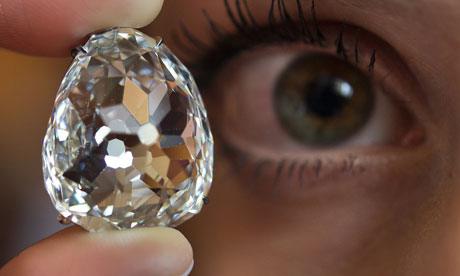- Jewel that began 400-year journey through European royalty in the crown of Henri IV’s second wife Maria Médicis sold for double the expected price

The eyecatching Beau Sancy diamond, the oldest diamond to go under the hammer at auction. Photograph: Fabrice Coffrini/AFP/Getty Images
As soon as she set eyes on the Beau Sancy diamond, Marie de Médicis, wife of the French king Henri IV, knew she wanted it, and she nagged her wayward husband until he bought it for her.
It was to bring neither of them great pleasure. In 1610, a day after her coronation – for which the large pear-shaped gem was set atop her crown – Henri was assassinated, leaving six children under the age of nine.
And so began the Beau Sancy’s 400-year journey through European royal history as it passed between warring and peacemaking monarchs in France, England, the Dutch Republic and Prussia.
On Tuesday the 34.98-carat jewel became the oldest diamond ever to go under the hammer at auction, selling for eight million francs (£5.3m) at Sotheby’s in Geneva, Switzerland. It was more than double the estimated top price.
“It is a very moving object,” said Sophie Dufresne, of Sotheby’s. “It is not just its perfect shape, but the impressive history that goes with it. There’s a kind of energy that radiates from it.”
The Beau Sancy, little sister of the Grand Sancy, now on display at the Louvre, in Paris, was believed to have been brought to France from India via Constantinople by the then ambassador of France, Nicolas de Harlay, Lord of Sancy, who gave the gem its name.
In 1604 the then queen consort was furious to discover that the bigger jewel had been sold, and set her heart on obtaining its sibling.
“She wanted that stone as soon as she knew that Nicolas de Harlay had sold le Grand Sancy to the king of England, James I, for his wife,” a Sotheby’s spokesperson told the Parisien newspaper.
King Henri was already in his 50s when he married De Médicis, daughter of the wealthy Italian aristocrats. He owed her Florentine family a considerable debt, which was conveniently written off when the couple wed, leading his mistress to nickname her “the fat banker”.
The relationship was tempestuous, not least of all because of his philandering. Henri was later killed by François Ravaillac, who wanted to stop the French king waging war against Spain.
In 1631, crippled with debts, De Médicis, now queen mother of France, fled to Brussels and later Amsterdam where she sold the Beau Sancy to the Dutch royal family, where it was used to seal the wedding of William II of Orange to Mary Stuart, daughter of King Charles I.
When William died, Stuart returned to England and pawned the jewel to fund her brother Charles II’s fight for the throne.
It returned to royal ownership when her son William III of Orange-Nassau married Mary II, with whom he jointly ruled England until her death in 1694. When he died without heirs, the Beau Sancy was returned to the Dutch family and then to the first Prussian kaiser, Frederick I, in 1701. It has passed down through generations of the House of Prussia until now.
The Beau Sancy was part of Sotheby’s Magnificent Jewels and Noble Jewels auction. The sale, in which most lots sold for much more than their guide price, also featured a historic diamond once owned by Charles Edward Stuart, better known as Bonnie Prince Charlie.
Other highlights of the sale included a necklace with a 41-carat detachable pear-shaped diamond, an emerald and diamond necklace designed by Bulgari in the 70s, and a sapphire and diamond ring dating from the 1930s that once belonged to Queen Victoria Eugenie of Spain.
guardian.co.uk, Wednesday 16 May 2012

No comments:
Post a Comment